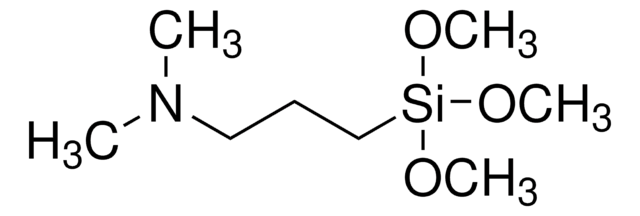440809
N-[3-(Trimethoxysilyl)propyl]aniline
Sinónimos:
Trimethoxy[3-(phenylamino)propyl]silane, (3-Anilinopropyl)trimethoxysilane, N-[3-(Trimethoxysilyl)propyl]aniline, [3-(Phenylamino)propyl]trimethoxysilane
About This Item
Productos recomendados
form
liquid
Quality Level
refractive index
n20/D 1.506 (lit.)
bp
310 °C (lit.)
density
1.07 g/mL at 25 °C (lit.)
SMILES string
CO[Si](CCCNc1ccccc1)(OC)OC
InChI
1S/C12H21NO3Si/c1-14-17(15-2,16-3)11-7-10-13-12-8-5-4-6-9-12/h4-6,8-9,13H,7,10-11H2,1-3H3
InChI key
KBJFYLLAMSZSOG-UHFFFAOYSA-N
¿Está buscando productos similares? Visita Guía de comparación de productos
Categorías relacionadas
General description
Application
signalword
Danger
Hazard Classifications
Aquatic Chronic 3 - Carc. 2 - Eye Dam. 1 - Muta. 2 - Skin Corr. 1B - Skin Sens. 1 - STOT RE 1
target_organs
Blood
Storage Class
6.1C - Combustible acute toxic Cat.3 / toxic compounds or compounds which causing chronic effects
wgk_germany
WGK 2
flash_point_f
230.0 °F - closed cup
flash_point_c
110 °C - closed cup
Elija entre una de las versiones más recientes:
¿Ya tiene este producto?
Encuentre la documentación para los productos que ha comprado recientemente en la Biblioteca de documentos.
Los clientes también vieron
Global Trade Item Number
| Número de referencia del producto (SKU) | GTIN |
|---|---|
| 440809-250ML | |
| 440809-50ML | 4061832253473 |
Nuestro equipo de científicos tiene experiencia en todas las áreas de investigación: Ciencias de la vida, Ciencia de los materiales, Síntesis química, Cromatografía, Analítica y muchas otras.
Póngase en contacto con el Servicio técnico






![Trimethoxy[3-(methylamino)propyl]silane 95%](/deepweb/assets/sigmaaldrich/product/structures/236/724/a4aa90e7-bf25-425f-9e44-cbc87ffac9fd/640/a4aa90e7-bf25-425f-9e44-cbc87ffac9fd.png)




